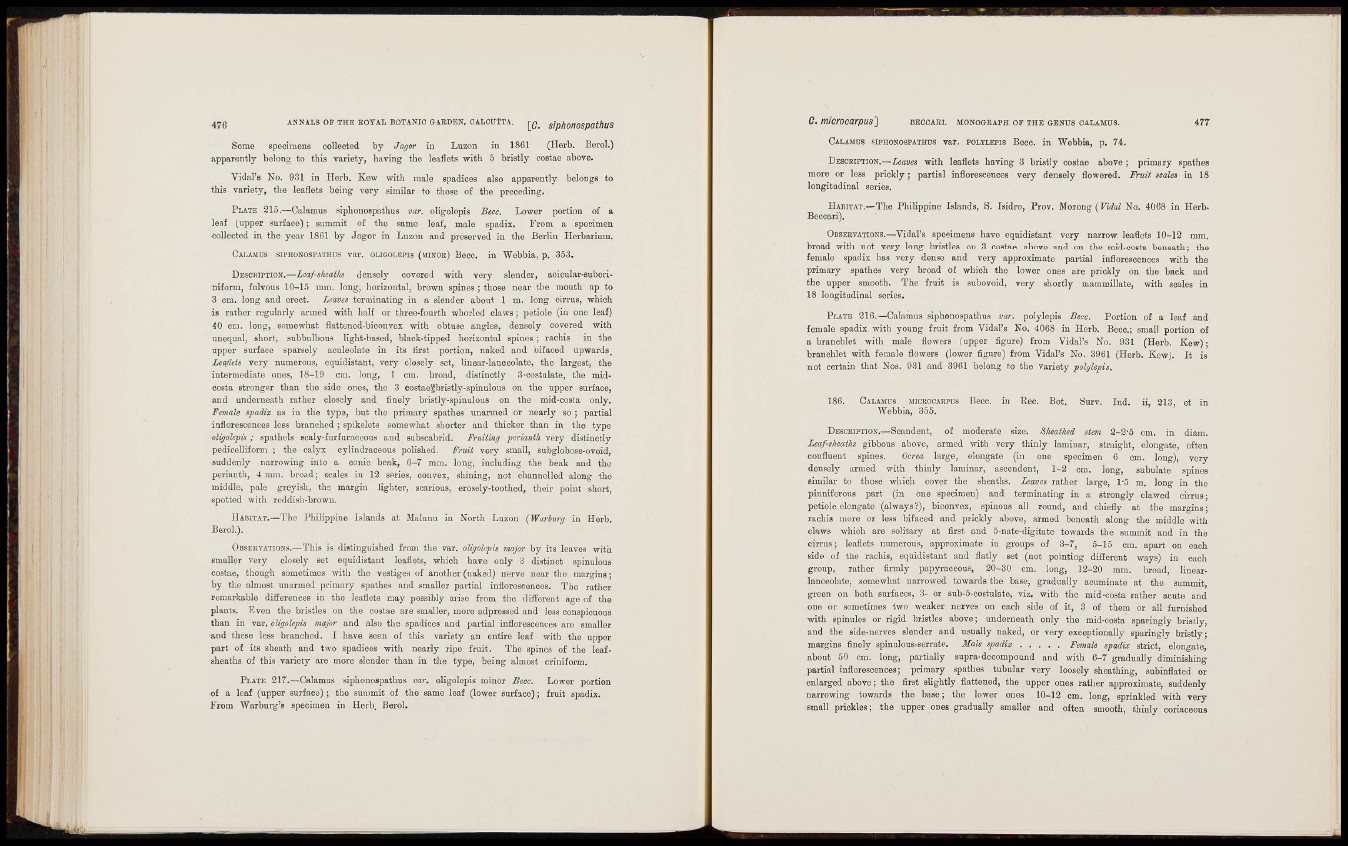
4 7 6 ANNALS OF THE EOYAL BOTANIC GARDEN, CALCUTTA. SLPHONOSPATHUS
Some specimens collected by J a p r in Luzon in 1861 (Herb. Berol.)
apparently belong to this variety, having the leaflets with 5 bristly costae above.
VidaVe No. 931 in Herb. Kew with male spadices also apparently belongs to
this variety, the leaflets being very similar to those of the preceding.
PLATE 215.—Calamus siphonospathus var. oligolopis Beac. Lower portion of a
leaf (upper surface); summit of the same leaf, male spadix. From a apedmen
collected in the year 1861 by Jagor in Luzon and preserved in the Berlin Herbarium.
CALAMUS SIPHONOSPATHUS var. OLIQOLEPIS (MINOR) Becc. in Webbia, p. 353.
DESOKIPTION.—Lca/-sheat/i3 densely covered with very slender, acicular-suberiniform,
fulvous 10-15 mm. long, horizontal, brown spines ; those near the mouth up to
3 cm. long and erect. Leaves terminating in a slender about 1 m. long cirrus, which
i s rather regularly armed with half or three-fourth whorlcd claws; petiole (in one leaf)
40 caí. long, somewhat flattened-biconvex with obtuse angles, densely covered with
unequal, short, subbulbous light-based, black-tipped horizontal spines ; rachis in the
upper surface sparsely aculeolate in its first portion, naked and bifaced upwards.
Leaflets very numerous, equidistant, very closely set, linear-hmoeolate, the largest, the
intermediate ones, 18-19 cm. long, 1 cm. broad, distinctly 3-costulate, the midcosta
stronger than the side ones, the 3 costae^bristly-spinulous on the upper surface,
and underneath rather closely and finely bristly-spinulous on the mid-costa only.
Female spadix as in the type, but the primary spathes unarmed or nearly so ; partial
inflorescences less branched ; spikelets somewhat shorter and thicker than in the type
oligolepii ; spathels scaly-furfuraceous and subscabrid. Fruiting perianth very distinctly
pedicelliform ; the calyx cylindraceous polished. Fruit very small, subglobose-ovoid,
suddenly narrowing into a conic beak, 6-7 mm. long, including the beak and the
perianth, 4 mm. broad; scales in 12 series, convex, shining, not channelled along the
middle, pale greyish, ths margin lighter, scarious, erosely-toothed, their point short,
spotted with reddish-brown.
HABITAT.—The Philippine Islands at Malunu in North Luzon {Warburj in Herb.
Berol.).
OBSERVATIONS.—This is dietinguished from the var. oligolopis major by its leaves with
smaller very closely sot equidistant leaflets, which have only 3 distinct spinulous
costae, though sometimes with the vestigeo of another (naked) nerve near the margins;
by the almost unarmed primary spathes and smaller paitial inflorescences. The rather
remarkable differences in the leaflets may possibly arise from the different age of the
plants. Even the bristles on the costae are smaller, more adpressed and less conspicuous
than in var. oUgolepis major and also the spadices and partial inflorescences are smaller
and these less branched. 1 have seen of this variety an entire leaf with the upper
part of its sheath and two spadices with nearly ripe fruit. The spines of the leafsheaths
of this variety are more slender than in the type, being almost criniform.
PLATE 217.—Calamus siphonospathus var, oligolepis minor Becc. Lower portion
of a leaf (upper surface) ; the summit of the same leaf (lower surface); fruit spadix.
f r o m Warburg's specimen in Herb. Berol.
C. microcarpus'] BECCABL MONOGRAPH OF THE GENUS CALAMUS.
CALAMUS FIPFIONOSPATHUS var. POLTLEPIS Becc. in Webbia, p. 74.
DESCRIPTION.—Leaves with leaflets having 3 bristly costae above ; primary
more or less prickly ; partial inflorescences very densely flowered. Fruit scales in 18
longitudinal series.
HABITAT.—The Philippine Islands, S. Isidro, Prov. Morong {Vidal No. 4068 in Herb-
Beccari).
OBSERVATIONS.—Vidal's specimens have equidistant very narrow leaflets 10-12 mm,
broad with not very long bristles on 3 costae above and on the mid-costa beneath; the
female spadix has very dense and very approximate partial inflorescences with the
primary spathes very broad of which the lower ones are prickly on the back and
the upper smooth. The fruit is subovoid, very shortly mammillate, with scales in
18 longitudinal series.
PLATE 216.—Calamus siphonospathus var. polylepis Becc. Portion of a leaf and
idix with young fruit from Vidal's No. 4068 in Herb. Becc.; small portion of
a branchlet with male flowers (upper figure) from Vidal's No. 931 (Herb. Kew);
branchlet with female flowers (lower figure) from Vidal's No. 3961 (Herb. Kew). It is
not certain that Nos. 931 and 3961 belong to the variety polylepis.
186. CALAMUS MICEOCARPUS Becc.
Webbia, 355.
Rec. Bot. Surv. Ind. ii, 213, et
DESCKIPTION.—Scandent, oE moderate size. Bheaiked stem 2-2-5 cm. in diam.
Leaf-sheaths gibbous above, armed with very thinly laminar, straight, elongate, often
confluent spines. Oerea large, elongate (in one specimen 6 cm. long), very
densely armed with thinly laminar, ascendcnt, 1-2 cm. long, subulate spines
similar to those which cover the sheaths. Leaves rather large, 1-5 m. long in the
pinniferous part (in one specimen) and terminating in a strongly clawed cirrus;
petiole elongate (always?), biconvex, spinous all round, and chiefly at the margins;
rachia more or less bifaced and prickly above, armed beneath along the middle with
claws which are solitary at first and 5-nate-digitate towards the summit and in the
cirrus; leaflets numerous, approximate in groups of 3-7, 5-15 cm. apart on each
side of the rachis, equidistant and flatly set (not pointing different ways) in each
group, rather firmly papyraceous, 20-30 cm. long, 12-20 mm. broad, linearlanccolate,
somewhat nan-owed towards the base, gradually acuminate at the summit,
green on both surfaces, 3- or sub-S-costulate, viz. with the mid-costa rather acute and
one or sometimes two weaker nerves on each side of it, 3 of them or all furnished
with epinules or rigid bristles above; underneath only the mid-costa sparingly bristly,
and the side-nerves slender and usually naked, or very exceptionally sparingly bristly;
margins finely spinulous-serrate. Male spadix Female spadix strict, elongate,
about 50 cm. long, pai-tially supra-decompound and with 6-7 gradually diminishing
partial inflorescences; primary spathes tubular very loosely sheathing, subinflated or
enlarged above; the first slightly flattened, the upper ones rather approximate, suddenly
narrowing towards the base; the lower ones 10-12 cm. long, sprinkled with very
small prickles; the upper ones gradually smaller and often smooth, thinly coriaceous